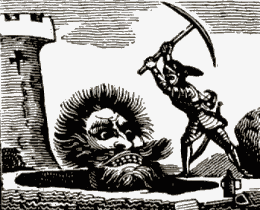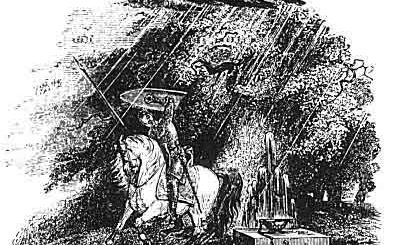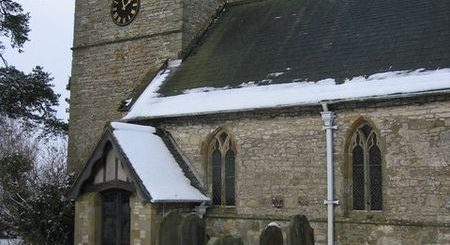Newstead Abbey
Newstead Abbey is a former Augustinian Priory which was taken over by the Crown during the Dissolution of Monasteries. It later became property of the Barons Byron: the best known member of this family is of course the eccentric and highly gifted George Gordon Byron, 6th Baron Byron (more often known as Lord Byron), but many other colorful characters trampled the Abbey’s lawns.
 The 4th Baron Byron renovated the house and carried out much needed and extensive works in the gardens. The 5th Baron, William Byron, first squandered a fortune rebuilding the house in Gothic style and then laid waste to the estate. He was widely known as an eccentric man, and as he grew older he became increasingly violent, to the point that he was nicknamed ‘The Wicked Lord’.
The 4th Baron Byron renovated the house and carried out much needed and extensive works in the gardens. The 5th Baron, William Byron, first squandered a fortune rebuilding the house in Gothic style and then laid waste to the estate. He was widely known as an eccentric man, and as he grew older he became increasingly violent, to the point that he was nicknamed ‘The Wicked Lord’.
Insanity must have run in the family because his only son, also named William, started a relationship with his own cousin, Juliana Byron. The Lord considered such a union as an unnatural act and desperately wanted his son to marry well to save the family from debts.
The Wicked Lord grew increasingly eccentric: his bouts of violence became more and more frequent and he started to take his rage on the Abbey itself. He deliberately destroyed many expensive pieces of furniture, had many trees cut down and is rumored to have killed the whole deer population of the Abbey. He outlived both his own son and grandson (who died fighting the French in Corsica) and upon his death the property passed on to the nearest surviving heir, Lord Byron.
Lord Byron was much fascinated by the property, now much dilapidated, but never lived there for long periods of time. His faithful Newfoundland dog, Boatswain, died at the Abbey in 1808 and was buried in a rich and extravagant tomb carrying an epitaph penned by the poet himself. Lord Byron expressely requested to be buried at Newstead next to his beloved dog but his heirs refused to carry out his will and buried him in the family tomb instead.
Lord Byron tried for many years to sell the property to ease his financial troubles and finally his agents found a buyer in 1817: Thomas Wildman, who spared no resources in restoring the Abbey to its pristine glory. The Abbey passed to various owners until it was presented to the Nottingham Corporation in 1931.
Legends and Hauntings
A well known local legend says that the ghost of Lord Byron’s dog Boatswain, has been often seen wandering the Abbey grounds, looking for his master: seeing this apparition is considered a very bad omen indeed.
A strange event is associated with ‘The Wicked Lord’, William Byron’s death: it is said that all the crickets living on property left it in swarms, never to return.




Re: Newstead Abbey
The Haunted Homes and Family Traditions of Great Britain by John Ingram (1897)
Like so many old baronial residences, Newstead has the reputation of beiug haunted, and that by more than one spectre. But the name and fame of the last of the Byron s of Newstead has over-clouded and obscured all previous tenants, mortal or otherwise, and flung a pall of poetic melancholy over the whole domain that no spiritual apparitions can survive. The legends connected with Newstead are manv, and descend from that mysterious maid of Saracen birth or residence, whose form and features are so frequently repeated in the ancient panel-work of the Abbey’s interior, down to Lord Byron’s immediate predecessor in the title and estates. "Devil Byron," as this man was called, among other wild tales connected with his name, was said to he haunted by the spirit of a sister, whom he refused to speak to for years preceding her death in consequence of a family scandal, notwithstanding her heart-rending appeals of " Speak to me, my lord ‘ Do speak to me ! – Ebenezer Elliott, in a ballad he wrote on this legend, int/oduces the apparitions of both * Devil Byron" and his sister as riding forth together in foul weather, the lady still making passionate appeals to the immovable brother to speak to her :
Well sleep the dead: in holy ground
Well sleeps the heart of iron;
The worm that pares his sister’s cheek,
What cares it for Byron?
Yet when her night of death comes round,
They ride and drive together;
And ever, when they ride and drive,
Wilful is the weather.
On mighty winds, in spectre coach,
Fast speeds the heart of iron;
On spectre-steed, the spectre-dame
Side by side with Byron.
Oh, Night doth love her! Oh, the clouds
They do her form environ
The lightning weeps it hears her sob
"Speak to me, Lord Byron I"
On winds, on clouds, they ride, they drive.
Oh, hark, thou heart of iron!
The thunder whispers mournfully,
"Speak to her, Lord Byron I"
Another family apparition which is said to have haunted the old Abbey, was that of " Sir John Byron the Little, with the Great Beard." An ancient portrait of this mysterious ancestor, some few years since, was still hanging over the door of the great saloon, and
was said to sometimes descend at midnight from its sombre frame, and promenade the state apartments. Indeed, this ancient worthy’s visitations were not confined to night only ; one young lady, on a visit to the Abbey some years ago, positively asserting that in broad daylight, the room of his chamber being open, she saw Sir John the Little sitting by the fire-place, and reading out of an old-fashioned book.
Many other apparitions have been seen about this ancient time-honoured building, and Washington Irving mentions that a young lady, Lord Byron’s cousin, when she was staying at the Abbey, slept in the room next the clock, and that one night, when she was in bed, she saw a lady in white come out of the wall on one side of the room and go into the wall on the other side. Many curious noises and strange sights have been heard and seen by residents and visitors at Newstead; but the best known and most noted spectre connected with the place, and immortalised by Byron’s verse, is the "Goblin Friar." The particular chamber that this spectre is supposed to especially frequent, and which is known par excellence, as "the Haunted Chamber," adjoins Byron’s bed-room. During the poet’s residence this dismal-looking room was occupied by his page, a beautiful ooy, whom the scandal-loving female servants would have was a girl.
Lord Byron, and many others, not only believed in the existence of the Black Friar, but asserted that they had reallv seen it. It did not confine its visitations, however, to the "haunted chamber," but at night walked the cloisters and other portions of the Abbey:
A monk arrayed
In cowl, and beads, and dusky garb, appeared,
Now in the moonlight, and now lapsed in shade,
"With steps that trod as heavy, yet unheard.
This apparition is the evil genius of the Byrons, and its appearance portends misfortune of some kind to the member of the family to whom it appears. Lord Byron fully believed that he beheld this apparition a short time before the greatest misfortune of his life, his ill-starred union with Miss Millbanke. Alluding to his faith in these things, he said:
I merely mean to say what Johnson said,
That in the course of some six thousand years,
All nations have believed that from the dead
A visitant at intervals appears;
And what is strangest upon this strange head,
Is that whatever bar the reason rears
‘Gainst such belief, there ‘s something stronger still
In its behalf, let those deny who will.
And he thus introduces the presumed duties, as it were, of the Black Friar:
By the marriage-bed of their lords, ’tis said,
He flits on the bridal eve;
And ’tis held as faith, to their bed of death
He conies but not to grieve.
When an heir is born, he is heard to mourn.
And -when aught is to befall
That ancient line, in the pale moonshine,
He walks from hall to hall.
His form you may trace, but not his face,
Tis shadowed by his cowl;
But his eyes may be seen from the folds between,
And they seem of a parted soul.
Among the numerous people who have asserted that they saw the Black Friar was a Miss Kitty Parkins, a relative of the poet; and she is even said to have made a sketch of the apparition from memory.